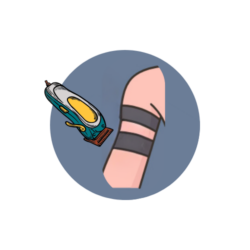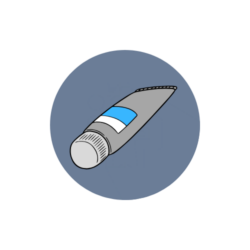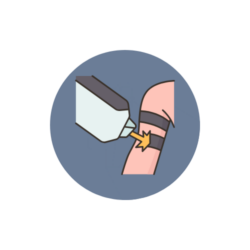Laser Tattoo Removal
Tattooing is an ancient art form, often embraced by individuals, especially at a younger age, as a form of self-expression. However, over time, people may choose to remove their tattoos for various reasons, such as lifestyle changes, religious beliefs, or personal preferences. Among the most effective and popular solutions today is laser tattoo removal, which uses advanced technology to break down tattoo pigments without leaving scars. But what exactly is laser tattoo removal, and how does the process work? Here’s everything you need to know.
Chose Your Topic
Get in Touch
Get professional treatments in Turkey at Lygos Clinic, offering effective, affordable treatments for a healthier and more aesthetically pleasing life.
You can contact us via WhatsApp and Instagram for a quick response.

What is Laser Tattoo Removal?
Laser tattoo removal is a highly effective method that uses specialized lasers, most commonly the Q-Switch Nd:YAG Fotona Q MAX device, to break down the pigments in tattoos. Unlike temporary tattoos that naturally fade, permanent tattoos require targeted treatment to remove.
This advanced device emits high-intensity light pulses that penetrate the skin and shatter tattoo ink into tiny particles. These particles are then naturally eliminated by the body’s immune system. The treatment is precise, safe, and designed to avoid damaging surrounding tissues, making it a preferred option for all skin types. The same technology is also used for treating pigmented lesions, skin rejuvenation, and vascular conditions.
How is Laser Tattoo Removal Done?
Before laser tattoo removal is done, a meeting is held with the doctor. The tattoo and skin analyzed by the doctor affect the treatment process. It should not be forgotten that since everyone’s needs are not the same, the planning will be done differently. Thanks to the examination before the procedure, it is decided which laser technology will be used.
Q-Switch Nd YAG Fotona Q MAX laser device is generally preferred for laser tattoo removal. Anesthesia can be applied before the procedure so that the patient does not feel pain. Then the procedure is started with laser technology. With the high-energy Q-Switch, laser tattoo removal is performed without damaging the skin.
This method, which has a fast healing process, has very few side effects. In this way, it is easily applied for every skin type. During laser tattoo removal, the skin surface is not damaged. The dark colored tattoo pigments in the skin are absorbed by laser light. The pigment in large pieces is separated into small particles by this method. This process takes place without causing any damage to the surrounding tissues. The body's immune system absorbs the tattoo dye, which is separated into small particles, more easily and ensures its destruction.


First Step
Consultation with a specialist to get information about the tattoo, skin type and health status.

Second Step
The treatment area may need to be cleaned and shaved.

Step Three
Usually a local anesthetic cream is applied to reduce discomfort during the procedure.

Step Four
The laser device is applied to the tattoo and breaks the pigments into pieces. There may be a slight feeling of discomfort during the procedure.
How Many Sessions Does Laser Tattoo Removal Take?
The number of sessions varies based on several factors:
Tattoo size and location
Ink type and depth
Skin tone and sensitivity
Laser type used
On average, 8 to 10 sessions are required, spaced 6 to 8 weeks apart to allow the skin to heal and pigment to fade effectively.
What are Side Effects of Laser Tattoo Removal?
While generally safe, some temporary side effects may occur:
- Redness and swelling
- Mild burning or tingling sensations
- Crusting or scabbing on the treated area
- Minor bruising or edema
These symptoms typically resolve within a few days. Following aftercare instructions helps reduce risks and supports optimal healing.

Is Laser Tattoo Removal Harmful?
Laser tattoo removal is not harmful. However, since the needs of each person are not the same, the right laser method should be determined. At the same time, a specialist should perform the procedure. Otherwise, laser tattoo removal may cause skin irritation.
Laser tattoo removal aims to fade the tattoo. The use of the latest technological products makes the process reliable. In this way, less damage is caused to the tissue during the procedure. The fact that the laser used in tattoo removal is also used in spot treatment shows that the method is reliable.
Things to Consider When Laser Tattoo Removal
The things to be considered during laser tattoo removal ensure a better result. Therefore, the recommendations given by the doctor for tattoo removal should be followed. Otherwise, both the healing process may be prolonged and undesirable results may occur.
Before tattoo removal, it is important to protect the area from sunlight. If the area to be removed is affected by the sun, the effect can be expected to disappear. During laser tattoo removal, the area and its surroundings are disinfected. The risk of infection of the area disinfected with special products is prevented.
The method determined for tattoo removal is also very critical. Since not everyone has the same skin type, the right laser method must be determined. In procedures where Q-Switch Nd YAG Fotona Q MAX laser device is generally preferred, the area where the tattoo is applied is also examined. With all these details, it is aimed to get the best result.
Another factor to be considered during laser tattoo removal is the dose adjustment. The dose adjustment of the device determined depending on the tattoo is also made and damage to the skin and tissues is prevented. After the application is completed, the medications given by the doctor should be used within the specified period.


Before and After Laser Tattoo Removal
To ensure the best outcome:
- Avoid sun exposure on the treatment area before and after sessions.
- Keep the area clean and dry for 24 hours post-treatment.
- Avoid hot environments like saunas, steam rooms, or hammams for at least a week.
- Do not scrub, pick, or apply makeup to the treated area.
- Follow all instructions and use any prescribed creams or medications as advised by your doctor.
Laser Tattoo Removal Aftercare
Laser tattoo removal significantly fades or eliminates tattoos over time. Before-and-after comparisons show smoother, clearer skin with minimal or no scarring. Because the procedure targets pigment while preserving the skin’s natural texture, it offers excellent cosmetic results.


Laser Tattoo Removal Costs
Pricing varies depending on:
- Tattoo size and complexity
- Number of sessions required
- Equipment used
- Clinic and doctor expertise
Larger tattoos and high-tech equipment may increase costs, but they also offer better, safer outcomes. Contact Lygos Clinic directly for a personalized quote.
Get in Touch
Get professional treatments in Turkey at Lygos Clinic, offering effective, affordable treatments for a healthier and more aesthetically pleasing life.
You can contact us via WhatsApp and Instagram for a quick response.
Frequently Asked Questions About Laser Tattoo Removal
When performed correctly, laser tattoo removal does not damage the skin or tissues, so scarring is very rare.
The laser targets pigment in the tattoo, breaking it into tiny particles that are naturally eliminated by the immune system.
Some discomfort may occur, but topical anesthesia is typically used to make the process more comfortable.
No, hair removal lasers are not suitable for tattoo removal. Tattoo removal requires specific lasers like Q-Switch Nd:YAG for effective pigment targeting.
BLOG

Is Breathing Through the Mouth Harmful?
Chose Your Topic Is Breathing Through the Mouth Harmful? Breathing is one of the most fundamental needs of life. However,

Does Rice Water Make Hair Grow? | Benefits of Rice Water
Chose Your Topic Does Rice Water Make Hair Grow? Natural methods in hair care have become quite popular in recent

Breast Lump | Types: Benign, Malign and Causes | LYGOS 2025
Breast Lump While cancer stands out as one of the most common health problems today, early diagnosis rates are also





